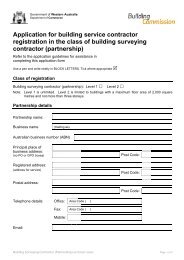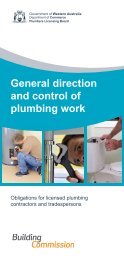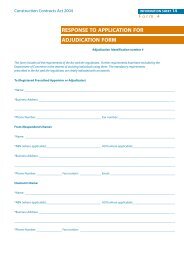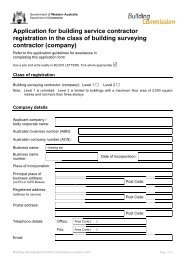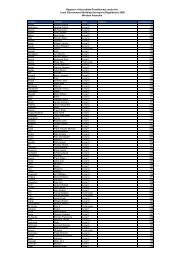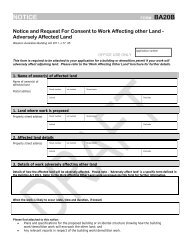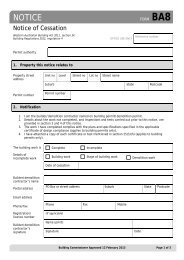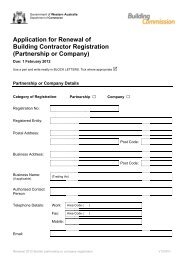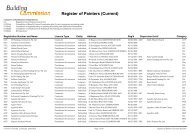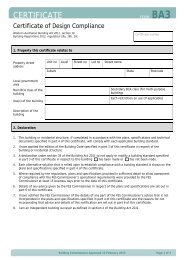A Guide to the New - Building Commission
A Guide to the New - Building Commission
A Guide to the New - Building Commission
You also want an ePaper? Increase the reach of your titles
YUMPU automatically turns print PDFs into web optimized ePapers that Google loves.
Suspension of <strong>Building</strong> or Demolition Permit - s35<br />
Suspension occurs when <strong>the</strong>re is no nominated builder or demolition contrac<strong>to</strong>r<br />
responsible for <strong>the</strong> work. This can occur if:<br />
<strong>the</strong> responsible person is dismissed or walks away from <strong>the</strong> job, and provides <strong>the</strong><br />
permit authority with a Notice of Cessation; or<br />
<strong>the</strong> responsible person ceases <strong>to</strong> be eligible under <strong>the</strong> Registration Bill.<br />
The permit has no effect from <strong>the</strong> start of <strong>the</strong> suspension until <strong>the</strong> relevant permit<br />
authority approves a new builder or demolition contrac<strong>to</strong>r, or until <strong>the</strong> permit<br />
expires.<br />
Work Affecting O<strong>the</strong>r Land - Part 6<br />
The extent <strong>to</strong> which a permit authority is concerned with work affecting o<strong>the</strong>r land is<br />
<strong>to</strong> check that <strong>the</strong> certificates supporting permit applications, for instance <strong>the</strong><br />
certificate of design compliance, show that <strong>the</strong> building work is likely <strong>to</strong> adversely<br />
affect neighbouring land. This covers building or demolition work that may adversely<br />
impact o<strong>the</strong>r land (or structures on <strong>the</strong> neighbouring land) by affecting its bearing<br />
capacity or drainage; cause <strong>the</strong> need for protection structures, such as underpinning<br />
or piling; change party walls or fences; or require encroachments or access on<strong>to</strong> <strong>the</strong><br />
o<strong>the</strong>r land.<br />
If this is <strong>the</strong> case, <strong>the</strong>re should be a notice and permission documents attached <strong>to</strong><br />
<strong>the</strong> application. If <strong>the</strong>re is no mention of <strong>the</strong> likelihood of <strong>the</strong> building work affecting<br />
o<strong>the</strong>r land on <strong>the</strong> supporting certificate, <strong>the</strong>n <strong>the</strong> permit authority can ei<strong>the</strong>r rely on<br />
this information, or can, when assessing <strong>the</strong> application, decide that <strong>the</strong>re is a<br />
likelihood of <strong>the</strong> building work affecting o<strong>the</strong>r land and request that consent is sought<br />
form <strong>the</strong> affected party.<br />
In circumstances where <strong>the</strong>re is a need <strong>to</strong> enter, or likelihood that <strong>the</strong> building work<br />
will affect, o<strong>the</strong>r land during construction, <strong>the</strong>re is now a formal process <strong>to</strong> follow.<br />
This process is primarily between <strong>the</strong> builder and <strong>the</strong> owner of <strong>the</strong> effected land.<br />
Consent from <strong>the</strong> owners of <strong>the</strong> land, or a court order, will be required before any<br />
work affecting o<strong>the</strong>r land is commenced, or any encroachment or access is made.<br />
35





